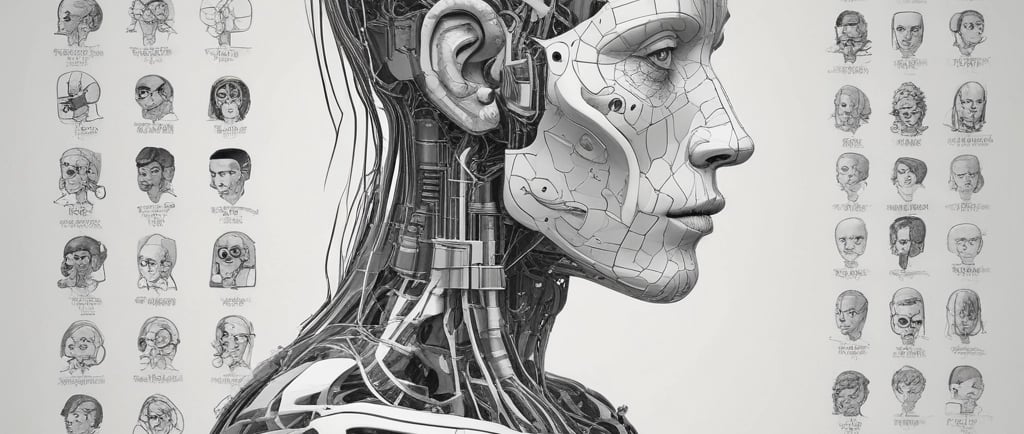Getting Started with AI: A Beginner's Guide to Creating Simple Projects
5 min read


Understanding the Basics of AI
Artificial Intelligence (AI) is a multifaceted field of computer science aimed at creating systems that can perform tasks typically requiring human intelligence. These tasks encompass a wide range of applications, including problem-solving, learning, perception, and language comprehension. At its core, AI focuses on developing algorithms and models that enable machines to mimic cognitive functions, thus enhancing efficiency and automating processes.
One of the foundational concepts of AI is machine learning, a subset of AI that enables systems to learn from data and improve their performance over time without being explicitly programmed. In machine learning, algorithms identify patterns within large datasets, allowing them to make predictions or decisions based on new information. Another critical area is deep learning, which utilizes neural networks with multiple layers to analyze complex data and extract features, effectively enabling machines to recognize images, comprehend speech, and even generate human-like text.
Natural Language Processing (NLP) is another vital component of AI. This branch focuses on the interaction between computers and humans through natural language. It aims to enable machines to understand, interpret, and generate human language in a way that is both meaningful and useful. Applications of NLP include language translation, sentiment analysis, and chatbots, all of which have transformed how we communicate with technology.
The relevance of AI in contemporary society cannot be overstated. From healthcare and finance to transportation and entertainment, AI technologies are increasingly integrated into everyday applications, making processes more efficient and enhancing decision-making capabilities. Understanding these fundamental concepts not only provides a groundwork for exploring more advanced AI topics but also fosters an appreciation for the transformative power of artificial intelligence in today's world.
Essential Tools and Technologies for AI Projects
For individuals embarking on their journey into artificial intelligence (AI), selecting the right tools and technologies plays a crucial role in project success. Among the myriad options available, programming languages and specialized libraries serve as foundational elements that every beginner should familiarize themselves with. Python is regarded as the primary language for AI development due to its simplicity and robust ecosystem. Its readability facilitates learning, making it an optimal choice for those new to programming.
Once beginners have established a basic understanding of Python, they can delve into several influential libraries that dramatically simplify the process of implementing AI algorithms. TensorFlow and PyTorch stand out as two of the most widely used frameworks in the AI community. TensorFlow, developed by Google, is excellent for creating deep learning models and is favored for its scalability. On the other hand, PyTorch, known for its dynamic computation graph and ease of use, has gained immense popularity among researchers and practitioners alike due to its flexibility in tasks ranging from basic neural networks to complex applications.
Additionally, platforms such as Google Colab and Kaggle provide accessible environments for experimentation and collaboration. Google Colab offers cloud-based Jupyter notebook capabilities, enabling users to execute Python code without extensive local setup, while also providing free access to GPUs for enhanced computational power. Meanwhile, Kaggle serves as both a community for data practitioners and a source of datasets, tutorials, and competitions that motivate learning through real-world challenges.
To effectively set up a working environment, beginners should start by installing Python and the necessary libraries using pip, Python's package installer. Managing environments through tools like Anaconda can be beneficial for avoiding compatibility issues. Furthermore, ensuring familiarity with version control systems such as Git will enhance collaboration on AI projects. Overall, selecting the appropriate tools and technologies is an essential step for those venturing into the world of AI.
Step-by-Step Guide to Building Your First AI Project
Embarking on your first AI project can be an exciting and fulfilling experience. This tutorial will guide you through the process of creating a basic image classifier, which is a practical introduction to artificial intelligence and machine learning. The objective is to develop a model that can recognize and classify images based on your specified categories.
To begin, define the project idea by identifying the types of images you want your classifier to recognize. For instance, you might choose to distinguish between cats and dogs. Once the project is outlined, gather a dataset containing labeled images for each category. Numerous publicly available datasets exist, such as those from Kaggle, Google Dataset Search, or even from your personal collection.
After collecting the data, you need to preprocess it. Preprocessing involves resizing images for uniformity, normalizing pixel values, and splitting the dataset into training and testing sets. Python libraries such as OpenCV or TensorFlow can facilitate these tasks while simplifying image manipulation and data handling. It is crucial to ensure that your dataset is sufficiently varied to improve the robustness of your AI model.
Next, you will start coding your project. Utilize frameworks like TensorFlow or PyTorch, as they provide comprehensive libraries for building and training neural networks. Begin by importing the necessary libraries and defining the architecture of your model. Construct layers suitable for image classification, such as convolutional layers, pooling layers, and fully connected layers. Ensure your code is modular to allow for easy debugging and testing.
Once your model is defined, compile it with an appropriate optimizer and loss function, and proceed to train it using the training dataset. Monitor the performance through validation metrics to prevent overfitting. After training, evaluate the model using the testing dataset to ascertain its accuracy.
Debugging may arise throughout this process; keep track of any errors you encounter and understand their origins. Testing your model with new or unlabelled data can also yield insights into its real-world applicability. Iterating on your project by tweaking parameters, trying different models, and experimenting with data augmentation can significantly improve your outcomes. Through this endeavored journey, you will not only enhance your AI skills but also develop confidence in building more advanced projects in the future.
Resources for Continued Learning and Exploration
As individuals embark on their journey in artificial intelligence (AI), it is essential to have access to a variety of learning resources that can support their development and understanding of this dynamic field. Fortunately, a wealth of materials is available for beginners eager to enhance their skills in AI through diverse formats such as online courses, tutorials, forums, and communities.
One valuable resource for structured learning is platforms like Coursera, edX, and Udacity, which offer comprehensive online courses covering foundational AI topics. Many of these courses are designed by industry leaders and universities, ensuring that learners receive up-to-date information and practical insights. Additionally, websites like Khan Academy provide free tutorials that can help solidify essential mathematical and programming concepts critical to grasping AI.
For those who prefer more interactive learning, engaging with online forums such as Stack Overflow or AI-specific communities on Reddit can be incredibly beneficial. Participating in discussions with peers and experts can aid in troubleshooting and provide fresh perspectives on common challenges faced while learning AI. Moreover, platforms like GitHub enable budding developers to collaborate on projects, sharing code and ideas with a global community.
In terms of literature, several books stand out as excellent starting points. "Artificial Intelligence: A Guide to Intelligent Systems" by Michael Negnevitsky and "Hands-On Machine Learning with Scikit-Learn, Keras, and TensorFlow" by Aurélien Géron are particularly helpful for gaining deeper insights into AI principles and practical implementations. Additionally, YouTube channels like 3Blue1Brown and Two Minute Papers offer engaging content that simplifies complex AI topics through visually appealing presentations.
To stay abreast of the latest advancements in AI, attending conferences such as NeurIPS, ICML, and CVPR can be invaluable. These events provide opportunities for networking, exposure to cutting-edge research, and interaction with pioneers in the field. Continuous learning in AI is not just about acquiring knowledge; it is also about nurturing creativity and innovation in a rapidly evolving landscape.
Comments
We value your feedback! Please share your thoughts and comments with us to help improve our services and better serve you.
Support
info@aiagentblogs.com
AI Agent Blogs
At aiagentblogs.com, we strive to bring you the latest insights and discussions on artificial intelligence, empowering you to stay informed and engaged in this rapidly evolving field.
Email:
© 2025. All rights reserved.
